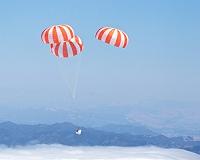 |
Manhattan KS (SPX) Aug 24, 2010 The final frontier may be no further than Manhattan, Kan., as a team of Kansas State University researchers launches a project funded by a $1.2 million grant from the National Aeronautics and Space Administration. The team - composed of Thomas Barstow, professor of kinesiology; Steven Warren, associate professor of electrical and computer engineering; Russell Taylor, an engineer in the Electronics Design Laboratory; and Carl Ade, a doctoral student in anatomy and physiology, Salina - will research what physical characteristics are necessary for an astronaut to perform lunar tasks. The team also will study ways to assess whether a person has enough physical capacity to perform the tasks. "Space travel is inherently dangerous," Barstow said. "The absence of gravity, which we call microgravity or zero gravity, causes our bodies to deteriorate in a variety of ways." A microgravity environment causes the weakening of muscles and the immune system, and it deteriorates the cardiovascular system's ability to regulate blood pressure. Barstow said this can affect an astronaut's ability to perform necessary tasks, such as climbing ladders, walking or opening doors. For the safety of the astronauts, NASA wants to make sure they are physically fit enough to perform those tasks during future missions to the moon and even Mars. "What seems like simple tasks as part of their life on the moon or other destinations could be life threatening if the astronauts aren't strong enough to do those tasks," Barstow said. The goal of the research, Barstow said, is to develop a simple test or a series of tests that astronauts can use in space to identify their physical conditioning and to determine if they have the capacity to perform lunar tasks. Each year of the three-year project will focus on a different aspect of space travel. In the first year the researchers will recruit 100 people to undergo an obstacle course of tasks that NASA has identified as simulating lunar activities - including dragging a dummy, climbing up and down ladders, pushing a wheelbarrow of rocks, and walking for 10 km. The participants also will perform physical fitness tests, such as running on a treadmill and arm exercises. Warren is developing sensors that the participants can wear to measure muscle activity and the oxygen circulating to them while performing the tasks. "We're hoping to get a fairly complete description of each person's muscle strength, muscle endurance and cardiovascular endurance, so that with the results of those tests, we then can predict their performances during the simulated lunar tasks," Barstow said. For the second year Warren and Taylor plan to develop a support system that can simulate different levels of gravity. The systems works by suspending the participant like a marionette - with cables that are attached to a platform and can be adjusted to simulate the moon's gravity or gravity on mars. The system is hung from a forklift, or telehandler, so that it can move across a terrain while the subject traverses a simulated moonscape. The third year researchers plan to observe participants performing the lunar tasks in space suits. Since the moon's gravity is one-sixth that of earth and Mars' gravity is three-eighths of the earth's, it will make some of the tasks easier than performing them on earth. But, Barstow said, the pressurized space suits that astronauts wear could make the tasks more difficult, especially tasks that require using hands to grip objects. The researchers also plan to develop special physical tests just for the arms and forearms. At the end of the three years the researchers hope to continue working with NASA to develop countermeasures, or ways the astronauts can maintain strength and endurance in space. Barstow said the project also creates research opportunities for kinesiology students, and he is looking for 15 to 20 students to help with research. The researchers are also looking for 100 people to participate in the study and for a building to perform the tests sheltered from the weather.
Share This Article With Planet Earth
Related Links Kansas State University Space Tourism, Space Transport and Space Exploration News
 SpaceX's Dragon Spacecraft Completes High Altitude Drop Test
SpaceX's Dragon Spacecraft Completes High Altitude Drop TestHawthorne CA (SPX) Aug 23, 2010 SpaceX has announced their Dragon spacecraft has successfully completed a high altitude drop test - meeting 100% of test objectives. This is the last in a series of tests to validate parachute deployment systems and recovery operations before the craft's first launch. During the August 12th test, an Erikson S-64F Air-Crane helicopter dropped a test article of the Dragon spacecraft from a h ... read more |
|
| The content herein, unless otherwise known to be public domain, are Copyright 1995-2010 - SpaceDaily. AFP and UPI Wire Stories are copyright Agence France-Presse and United Press International. ESA Portal Reports are copyright European Space Agency. All NASA sourced material is public domain. Additional copyrights may apply in whole or part to other bona fide parties. Advertising does not imply endorsement,agreement or approval of any opinions, statements or information provided by SpaceDaily on any Web page published or hosted by SpaceDaily. Privacy Statement |